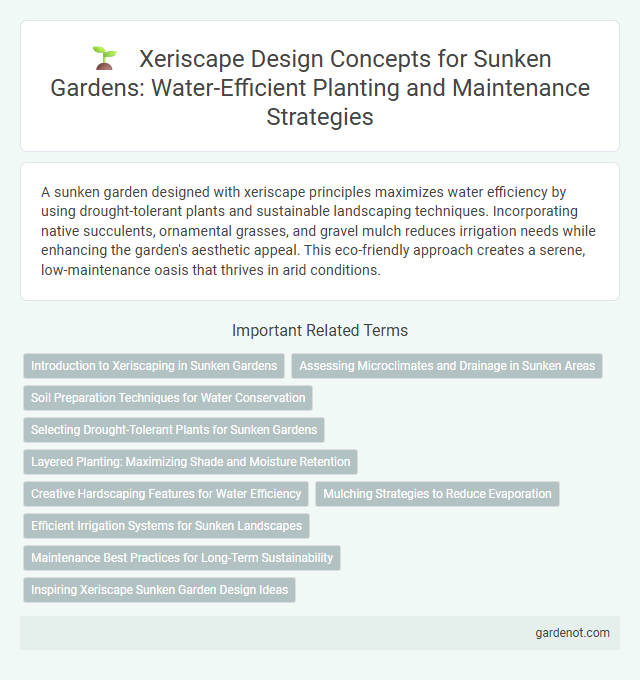A sunken garden designed with xeriscape principles maximizes water efficiency by using drought-tolerant plants and sustainable landscaping techniques. Incorporating native succulents, ornamental grasses, and gravel mulch reduces irrigation needs while enhancing the garden's aesthetic appeal. This eco-friendly approach creates a serene, low-maintenance oasis that thrives in arid conditions.
Introduction to Xeriscaping in Sunken Gardens
Xeriscaping in sunken gardens offers a sustainable landscaping solution that reduces water usage by incorporating drought-tolerant plants and efficient irrigation techniques. These gardens use strategic soil amendments, mulch, and native species to maximize moisture retention and minimize evaporation. Implementing xeriscape principles in sunken gardens enhances water conservation while maintaining aesthetic appeal in arid and semi-arid climates.
Assessing Microclimates and Drainage in Sunken Areas
Assessing microclimates and drainage in sunken gardens is crucial for successful xeriscape design, as these areas often experience varied sunlight exposure and water accumulation. Microclimate analysis highlights temperature fluctuations and wind patterns that affect plant selection, while proper drainage evaluation ensures soil moisture balance to prevent root rot and erosion. Incorporating permeable soils and strategically placed drought-tolerant plants enhances water efficiency and ecosystem resilience in these naturally water-retentive garden zones.
Soil Preparation Techniques for Water Conservation
Effective soil preparation techniques in xeriscape gardens prioritize enhancing soil structure to maximize water retention and minimize runoff. Incorporating organic matter such as compost improves soil porosity and nutrient content, promoting deep root growth essential for drought-resistant plants. Amending soil with materials like sand or perlite ensures optimal drainage while retaining moisture, crucial for sustainable water conservation in sunken garden designs.
Selecting Drought-Tolerant Plants for Sunken Gardens
Selecting drought-tolerant plants for sunken gardens enhances water efficiency by utilizing species like lavender, agave, and ornamental grasses that thrive in low-moisture environments. These plants reduce irrigation needs while maintaining aesthetic appeal through varied textures and colors suited for sunken garden microclimates. Incorporating native succulents and deep-rooted shrubs supports soil stability and resilience against dry spells in sunken landscape designs.
Layered Planting: Maximizing Shade and Moisture Retention
Layered planting in a xeriscape sunken garden maximizes shade and moisture retention by combining deep-rooted shrubs, medium-sized perennials, and ground covers to create a natural microclimate. This stratified approach reduces soil evaporation, conserves water, and supports diverse plant health in arid environments. Utilizing native drought-tolerant species further enhances sustainability and ecosystem balance.
Creative Hardscaping Features for Water Efficiency
Xeriscape gardens utilize creative hardscaping features such as permeable pavers, gravel pathways, and raised beds with efficient drip irrigation systems to maximize water conservation. Incorporating retaining walls and stone terraces helps manage water runoff while enhancing soil retention and reducing erosion in sunken garden landscapes. These design elements collectively optimize water use, promote sustainability, and maintain aesthetic appeal in xeriscape sunken gardens.
Mulching Strategies to Reduce Evaporation
Mulching strategies in a xeriscape garden significantly reduce evaporation by creating a protective barrier over the soil, maintaining moisture levels and lowering water demand. Organic mulches like bark chips or straw improve soil health while inorganic options such as gravel provide long-lasting coverage with minimal water loss. Effective mulching not only conserves water but also suppresses weed growth and moderates soil temperature in sunken garden designs.
Efficient Irrigation Systems for Sunken Landscapes
Efficient irrigation systems in sunken landscapes utilize drip irrigation and smart moisture sensors to minimize water waste while promoting healthy xeriscape gardens. Incorporating subsurface drip lines and automated timers ensures targeted water delivery directly to plant roots, enhancing water conservation in drought-prone environments. These systems reduce runoff and evaporation typically associated with sunken garden irrigation, supporting sustainable landscaping practices.
Maintenance Best Practices for Long-Term Sustainability
Xeriscape gardens require minimal water, reducing irrigation needs and conserving resources effectively. Regular pruning and soil amendment with organic mulch enhance plant health and moisture retention. Implementing drip irrigation systems and monitoring soil moisture levels prevent overwatering, promoting long-term garden sustainability.
Inspiring Xeriscape Sunken Garden Design Ideas
Xeriscape sunken garden designs optimize water conservation by incorporating drought-resistant plants like succulents, lavender, and ornamental grasses that thrive in arid conditions. These gardens use layered mulch and efficient drip irrigation systems to reduce evaporation and runoff, maintaining soil moisture while enhancing visual appeal. Integrating natural stone terraces and rainwater harvesting features creates functional, eco-friendly landscapes that inspire sustainable gardening in sunken garden layouts.
Xeriscape garden Infographic

 gardenot.com
gardenot.com